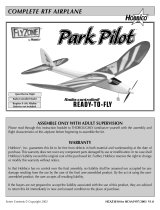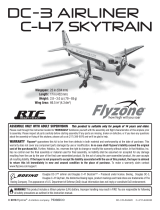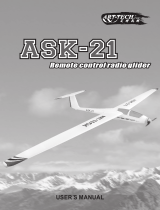
18
The Calypso is simply hand-launched by advancing the throttle
and giving it a gentle toss directly into any prevailing wind—it
will basically fl y out of your hand, so a gentle throw is all that
is needed. You’ll probably want to launch it at full-throttle the
fi rst time, but once you get used to the Calypso and get it
trimmed you could launch it at reduced power.
Once airborne the fi rst priority will be to get your Calypso
trimmed for straight-and-level fl ight using the fl ight trims on the
transmitter. The elevator may trim out differently at full power
than it does power off, so trim it for the type of fl ying you will
be doing most—sport-fl ying or thermaling (if thermaling you
will want the Calypso to trim out with the power off).
You can maneuver the Calypso around the sky rather like a
sport model performing gentle aerobatics such as loops, rolls,
Cuban 8s, stall turns and even inverted fl ight, or you can fl y
it like a glider using motor power to climb to altitude, then
shut off the power to search for lifting air. When searching for
thermals you’ll fi nd that the Calypso will appear to just about
“hang” in the air with the fl aps extended.
When ready to land simply bring the Calypso around into the
wind, cut the power and allow it to descend. You can extend
the fl aps to slow the Calypso’s descent, but this may also
extend the glide path so modulate the fl aps as necessary. In
breezy conditions the Calypso may descend almost vertically.
However you fl y you should calculate your fi ght time and
use a timer so you don’t over discharge your battery or end
up having the motor quit unexpectedly causing a dead-stick
landing. Dead-stick landings are usually no problem unless
you are fl ying on a windy day and cannot get your Calypso
back to the landing area.
EXPERT TIP: At full-throttle the Calypso consumes
approximately 210 mAh/minute which should provide at
least 5 minutes of motor run time on a 1300 mAh battery—
usually enough for fi ve one-minute, full-throttle climbs. But
the actual run time you can expect may vary depending
on several factors such as the condition of your batteries,
the average throttle setting and even the wind conditions
(fl ying on windy days you seem to use more power than
when fl ying on calm days).
To fi nd out for yourself how long you can fl y, set your timer to
3 minutes for the fi rst fl ight. Fly until the timer sounds, then
land. Use a charger with a digital display to fi nd out how much
capacity it took to recharge the battery (indicating how much
capacity was used). To ensure against over discharging the
target is to use 80% of your battery’s capacity, so multiply
your battery’s capacity by .8 to fi nd out how much you have
available. Compare the capacity used to 80% of your battery’s
capacity and adjust your fl ight time accordingly.
For example: If using the recommended 1300mAh battery,
your target capacity you want to use for a fl ight is 1040 mAh
(1300 mAh x .8 = 1040mAh). If you fl ew for three minutes
and it took 660 mAh to recharge your battery, you still had
380 mAh to go before you could have landed, so adjust
your timer to increase your fl ight time accordingly until you
reach your 1040mAh target. (You could also divide 660 mAh
by three minutes to fi gure a current consumption rate of
220 mAh/minute. Divide 1040 mAh by 220mAh/minute to
conclude that you can fl y for 4.7 minutes [4 min. 40 sec.]—
but round down to 4-1/2 minutes.)
Keeping records over a period of time will allow you to
accurately calculate your target fl ight time.
One fi nal note about fl ying your model. Have a goal or fl ight
plan in mind for every fl ight. This can be learning a new
maneuver(s), improving a maneuver(s) you already know,
or learning how the model behaves in certain conditions
(such as on high or low rates). This is not necessarily to
improve your skills (though it is never a bad idea!), but more
importantly so you do not surprise yourself by impulsively
attempting a maneuver and suddenly fi nding that you’ve run
out of time, altitude or airspeed. Every maneuver should be
deliberate, not impulsive. For example, if you’re going to do a
loop, check your altitude, mind the wind direction (anticipating
rudder corrections that will be required to maintain heading),
remember to throttle back at the top, and make certain you
are on the desired rates (high/low rates). A fl ight plan greatly
reduces the chances of crashing your model just because
of poor planning and impulsive moves. Remember to think.
Have a ball! But always stay in control
and fl y in a safe manner.
GOOD LUCK AND GREAT FLYING!


























